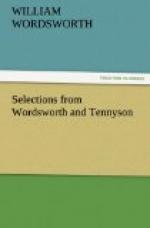Wordsworth possessed every attribute necessary to the descriptive poet,—subtle powers of observation, ears delicately tuned to seize the very shadow of sound, and a diction of copious strength suggestive beyond the limits of ordinary expression. Yet purely descriptive poetry he scorned. “He expatiated much to me one day,” writes Mr. Aubrey de Vere, “as we walked among the hills above Grasmere, on the mode in which Nature had been described by one of the most justly popular of England’s modern poets—one for whom he preserved a high and affectionate respect [evidently Sir Walter Scott]. ‘He took pains,’ Wordsworth said; ’he went out with his pencil and note-book, and jotted down whatever struck him most—a river rippling over the sands, a ruined tower on a rock above it, a promontory, and a mountain-ash waving its red berries. He went home and wove the whole together into a poetical description.’ After a pause, Wordsworth resumed, with a flashing eye and impassioned voice; ’But Nature does not permit an inventory to be made of her charms! He should have left his pencil and note-book at home, fixed his eye as he walked with a reverent attention on all that surrounded him, and taken all into a heart that could understand and enjoy. Then, after several days had passed by, he should have interrogated his memory as to the scene. He would have discovered that while much of what he had admired was preserved to him, much was also most wisely obliterated; that which remained—the picture surviving in his mind—would have presented the ideal and essential truth of the scene, and done so in a large part by discarding much which, though in itself striking, was not characteristic. In every scene many of the most brilliant details are but accidental; a true eye for Nature does not note them, or at least does not dwell on them.’”
The student should learn to compare the descriptive methods of Coleridge and Wordsworth. See especially Lowell’s note quoted on pp. 197-198; also see pp. 47 f.
INFLUENCE OF NATURAL OBJECTS
This poem was composed at Goslar in 1799 as part of the first book of The Prelude (published in 1850). It was first printed in Coleridge’s periodical The Friend, in December, 1809, with the instructive though pedantic title, “Growth of Genius from the Influences of Natural Objects on the Imagination, in Boyhood and Early Youth.” It appeared in Wordsworth’s poems of 1815 with the following title:—“Influence of Natural Objects in calling forth and strengthening the Imagination in Boyhood and Early Youth.”
The opening verses of this poem are still another instance of the identification of God with nature. As Mr. Stopford Brooke writes, “we are here in contact with a Person, not with a thought. But who is this person? Is she only the creation of imagination, having no substantive reality beyond the mind of Wordsworth? No, she is the poetic impersonation of an actual Being, the form which the poet gives to the living Spirit of God in the outward world, in order that he may possess a metaphysical thought as a subject for his work as an artist.”




